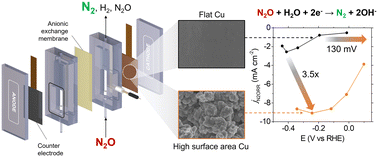Development of a high surface area Cu electrocatalyst for effective nitrous oxide reduction reaction†
Abstract
Electrochemical reduction of nitrous oxide (N2ORR) into benign nitrogen (N2) under mild reaction conditions is one approach for reducing emissions of this long-lived anthropogenic greenhouse gas and their environmental impact. In this work, high surface area Cu was investigated as a non-noble N2ORR catalyst alternative to conventional noble metals such as Pd, Pt, and Ir. Nanostructured Cu2O was electrodeposited onto a Cu substrate and electrochemically reduced to metallic Cu prior to the reaction. When compared to a flat Cu electrode, the high surface area Cu results in a 130 mV improved onset potential and 3.5 times higher N2 partial current density. The specific activity of the high surface area Cu indicates that the improved activity is due to the increased electrochemically active surface area. However, the mass transport of reactants becomes limiting at a very large surface area. Peak activity is observed on a Cu electrode with a surface area that is ∼30 times the geometric surface area. The stability test shows that the electrode can maintain its high surface area and catalytic activity for at least 7 hours, demonstrating that high surface area Cu is a viable alternative to noble metal N2ORR catalysts, outperforming other non-noble catalysts previously reported.

- This article is part of the themed collection: Emerging Investigator Series


 Please wait while we load your content...
Please wait while we load your content...